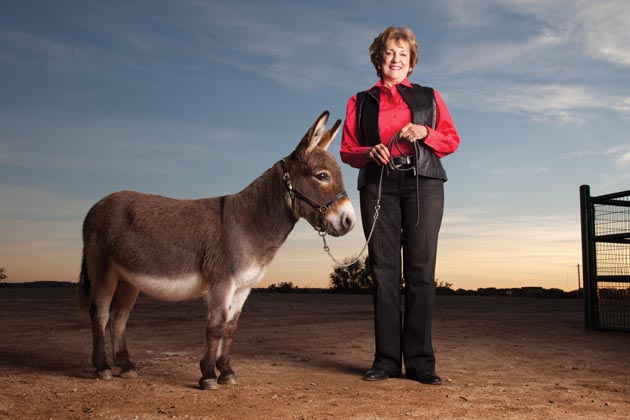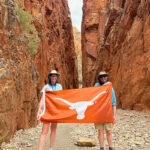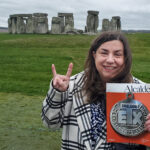Rodeo Club Took Bulls by the Horns
 They’d grown up everywhere in the state, from dusty Lubbock to stately River Oaks, but they were all Texas kids and proud of it. Likewise, they loved The University of Texas. But the one thing UT needed, this ranch-loving handful of ’50s students agreed, was an official rodeo club.
They’d grown up everywhere in the state, from dusty Lubbock to stately River Oaks, but they were all Texas kids and proud of it. Likewise, they loved The University of Texas. But the one thing UT needed, this ranch-loving handful of ’50s students agreed, was an official rodeo club.
With horses, broncos, and arenas involved, starting up a rodeo team was more complicated than forming a chess club. So in 1956, the group of friends took their request to the UT Board of Regents— who shot it down.
“They told us that if we wanted to have anything to do with rodeos or anything to do with agriculture, we should all go to Texas A&M,” Rhetta Moody McAlister, BS ’60, remembers.
Today McAlister is a miniature-donkey rancher who has been nominated for the National Cowgirl Hall of Fame. Back in 1956 she was just a college freshman, but she’d been a national barrel-racing champion in high school and was eager to keep the dance going.
The regents hadn’t counted on the determination—or well-connectedness—of this group. Several of its members, such as John Mecom Jr., ’58, and Reese Lockett Jr., BBA ’60, Life Member, hailed from Texas families prominent in everything from oil to trail-riding.
Within weeks, the students were back with a petition in favor of a UT-sponsored rodeo team. Among its 2,000-some signers were Gov. Price Daniel, Sen. Lyndon Baines Johnson, and the iconic Roy Rogers. This time, miraculously, they got the go-ahead.
And they charged. As the ’50s closed out, Los Charros Inc., as the rodeo club officially named itself, came roaring onto the UT social scene. Within three years it had grown to 200 members and hundreds more hangers-on.

Photo by Michael O’Brien
The Charros built a 7,500-seat arena, hosted the country’s largest college rodeo, threw dances and barbecues, invited famous singers to perform, and even captured national news coverage.
“I know we had more fun than anyone else at the University,” says McAlister’s sister, Bebe Moody Boone, BS ’59, Life Member.
The Moody girls were even pictured in Sports Illustrated in 1959. Rodeos, the story said, had been introduced everywhere from Alaska to Maine. “At the University of Texas,” it went on, “they are even part of college life, and two outstanding members of Los Charros—the college riding and barbecue society—are the Moody sisters.”
Two women at a time could compete on a college rodeo team, their events being barrel-racing and goat-tying. McAlister, Boone, and their friend Coco Amerman Blackbird, ’57, alternated between the two spots.
On the night she pledged Pi Beta Phi sorority, Blackbird had on a tremendous white organza hoop skirt, she says—with Levis and cowboy boots underneath. Club president Carey Crutcher picked her up from the pledge lines, and they sped off to rodeo.
The Charros went racing to competitions everywhere from Huntsville to Lake Charles, but they also wanted to host a rodeo at home. For their spring 1957 edition, which coincided with Round-Up, they made do with a temporary arena.
 For the next year, however, they decided to build their own. Friends in high places helped; along with Gov. Price Daniel, his brother and fellow politician Bill Daniel became a big Charros supporter. Charros member Ann Dudgeon Phy, ’56, remembers the club being invited to breakfast in the governor’s mansion.
For the next year, however, they decided to build their own. Friends in high places helped; along with Gov. Price Daniel, his brother and fellow politician Bill Daniel became a big Charros supporter. Charros member Ann Dudgeon Phy, ’56, remembers the club being invited to breakfast in the governor’s mansion.
And so the state government agreed to loan them 25 acres for 10 years. Situated at the split of Lamar and Guadalupe streets, near what is now the Triangle, the land was at that time considered Austin’s northern edge.
The members sought donated materials from Texas corporations to build the $40,000 arena. Photos show the students, even the women among them, stripping cedar posts and erecting steel stands — although as McAlister remembers it, there were construction experts on hand to make sure the bleachers were study enough to hold 7,500 without collapsing.
With the help of Charros publicity chair John Barnhill, BJ ’59, Life Member, Distinguished Alumnus, the project grabbed headlines. As a journalism major, Barnhill says, he had “just enough savvy to know what it took to get stuff in the paper.” Starting a benefit night at the rodeo, for instance, got attention; in 1958, the club brought more than 3,000 underprivileged children to see the spectacle.
“It probably didn’t help my grades at UT, but I got stories in the Austin American-Statesman almost every week about the rodeo club,” Barnhill says. “We met with Carey at the Night Hawk restaurant when we really should have been studying.”
The arena the students built was functional, but in bad weather, it wasn’t always pretty. On stormy days, Boone says, the Charros would still practice—they just called it the “muddy-o.”
“My mother would feel sorry for us and say the arena was a big lake or a mud hole,” she says. “Our parents were thinking we were miserable doing this, but we’d slop around out there and thought it was just great.”
Even more wild times were had when the men on the team competed in wild-cow-milking contests. This particular event required squeezing milk from a feisty, kicking cow not into a bucket, but instead into a Coke bottle. A roper would snag the heifer, a “mugger” or two would clamber onto her to slow her down, and a milker would run up with the bottle, fill it up, and race across the finish line. Miraculously, no person—or cow—was ever injured, Boone says.
 Most of the Charros members were looking for fun times as much as serious competition. One year, Blackbird had the nerve to call country-western singer Marty Robbins to ask him to perform at their rodeo.
Most of the Charros members were looking for fun times as much as serious competition. One year, Blackbird had the nerve to call country-western singer Marty Robbins to ask him to perform at their rodeo.
This was three weeks before Robbins’ star-making album, Gunslinger Ballads and Trail Songs, was released, onetime Charros president Larry Gardner says. The club contracted Robbins for two or three nights for a low-low-low $1,500. “That’s why we were able to get him for the price we did,” Gardner says. “He was gracious enough to stick to that price. But it was a pretty big deal—that album really made him.”
Naturally, the singer of what became a #1 hit single, “El Paso,” drew thousands. “It was like you build it and they will come,” Blackbird says. “I’ll never forget standing at that V [between Guadalupe and Lamar]. There were lights coming from both directions, and they were coming to see Marty Robbins.”
As for the rodeo competition, the team had a big win when Larry O’Neill, BAr ’63, Life Member, tied for the national collegiate championship in bareback riding in 1959.
Eight seconds on a frantically bucking horse could be plenty exciting, O’Neill says. “After you’ve done it enough times,” he says, “everything kind of slows down. Plus there was kind of a high to it.”
Those were the triumphs. The next year, though, a horse fell on O’Neill and broke his foot. Bogged down with architecture coursework anyway, he reluctantly quit the Charros.
Glory is fleeting, and the Charros found that as their other mainstays began to graduate, there weren’t enough younger students enthusiastic about rodeo to keep it going. Successive years of the Cactus yearbook tell the story: in 1960, the pictured group was smaller. The next year, it put on a horse show rather than a rodeo. By 1962, it was gone.
The original members tend to look back on their rodeo club days as high times, and as is often the case, it takes an outsider to put its significance in context. McAlister’s husband, Jim, who went to OU, listens as his wife describes them confronting regents, circulating a petition, seeking out donations, and building a stadium—all as 18- and 19-year-old students. He shakes his head in amazement.
“It just goes to show,” he says, “how much a group of young people can accomplish when they put their minds to it and work together.”

















No comments
Be the first one to leave a comment.